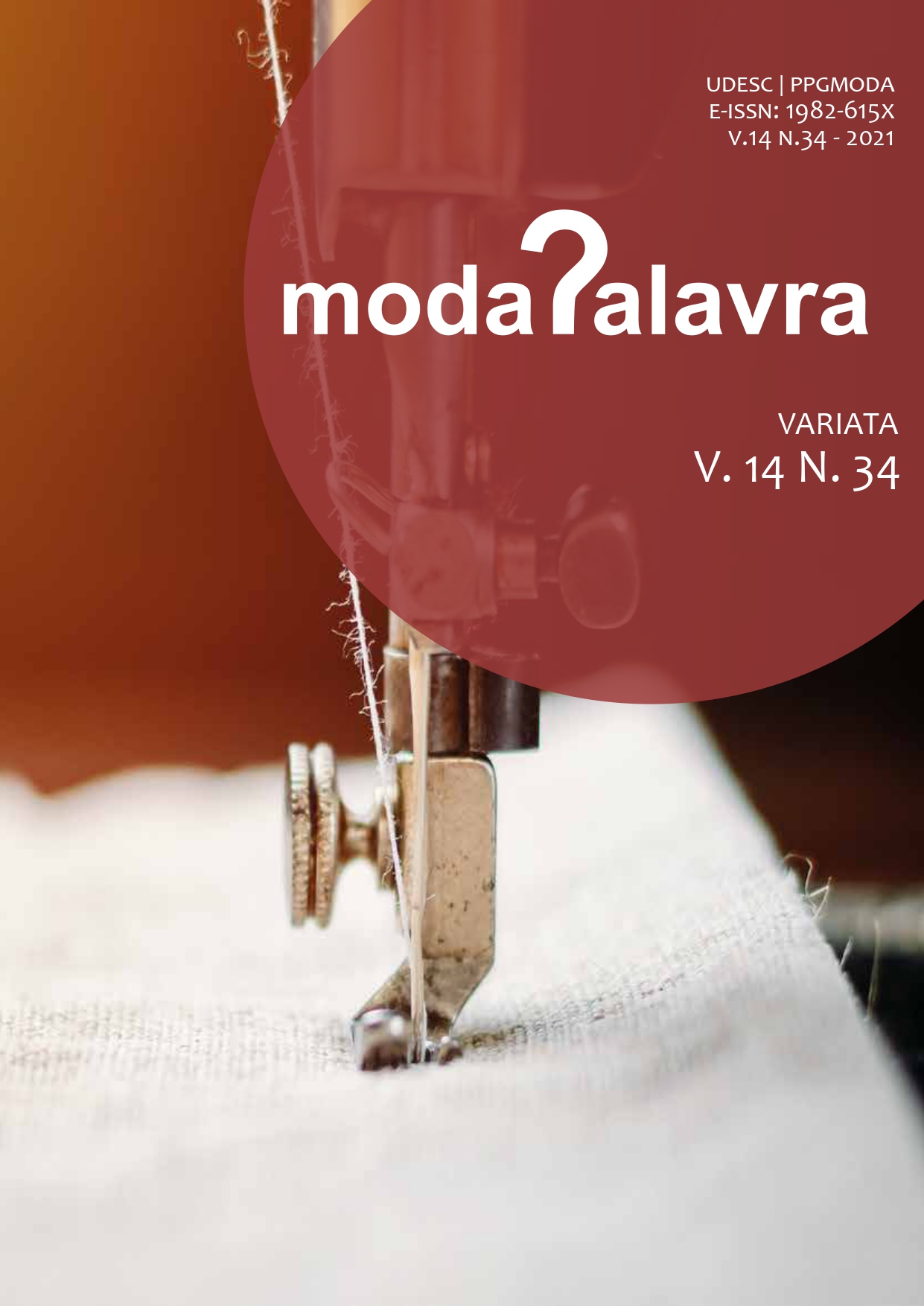Cotton fabrics in the fashion context: classification as regards the environmental impact
DOI:
https://doi.org/10.5965/1982615x14342021061Keywords:
Fashion, Cotton fabrics, ClassificationAbstract
This article presents the main results of an investigation developed on the Professional Master Degree in Design and describes the productive processes used at the textiles industries, specifically in their primary and secondary sections. The main objective of the research project was to analyze the productive processes of circular knitted fabrics largely used in the Brazilian industry, from the cotton cultivation to the improvement/finish techniques of the products, pointing out environmental effects, in order to compare the procedures and the fabric classification. The applied methodology contains theoretical information, field research–in order to gather the data–, data analysis and the development of a table. The more important results are about the ecological indexes of the cotton fabric classification when it comes to the environmental impact, presented in the table. The article tries to spread the knowledge concerning conscious consumption about the textile and clothing products.
Downloads
References
ALBUQUERQUE, Fabio Alquino de. Fábio Alquino de Albuquerque: questionário [out. 2018]. Barbalha, 2018. Entrevistadora: Silvana Silva Reiter Witkoski. E-mail.
ARAÚJO, Mário D.; CASTRO, E. M. de Melo. Manual de engenharia têxtil. Lisboa: Fundação Calouste Gulbenkian, 1986.
ASSOCIAÇÃO BRASILEIRA DE NORMAS TÉCNICAS (ABNT). NBR ISO 14001. Sistemas de gestão ambiental: requisitos com orientações para uso. Rio de Janeiro: ABNT, 2015.
ASSOCIAÇÃO BRASILEIRA DOS PRODUTORES DE ALGODÃO (Abrapa). Câmara Temática de Insumos Agropecuários – CTIA. Abrapa, 2017. Disponível em: http://www.agricultura.gov.br/assuntos/camaras-setoriais-tematicas/documentos/camaras-tematicas/insumos-agropecuarios/2017/90a-ro/app_gtfertilizantes_90ro_insumos.pdf. Acesso em: 16 ago. 2018.
ASSOCIAÇÃO BRASILEIRA DOS PRODUTORES DE ALGODÃO (Abrapa). Estatuto da Abrapa. 2014. Disponível em: http://www.abrapa.com.br/Paginas/institucional/estatuto-e-regimento.aspx. Acesso em: 10 maio. 2018.
ASSOCIAÇÃO BRASILEIRA DOS PRODUTORES DE ALGODÃO (Abrapa). Portal. Disponível em: <http://www.abrapa.com.br>. Acesso em: 20 jul. 2018.
ASSOCIAÇÃO BRASILEIRA DOS PRODUTORES DE ALGODÃO (Abrapa). Regulamento do Programa Algodão Brasileiro Responsável (ABR) com opção de adesão ao Programa Better Cotton (BCI). Abrapa, 2013. Disponível em: http://www.abrapa.com.br/BibliotecaSustentabilidade/ABR%20%E2%80%93%20Algod%C3%A3o%20Brasileiro%20Respons%C3%A1vel/Regulamento_ABR%202013.14.pdf. Acesso em: 20 jul. 2018.
ASSOCIAÇÃO MATO-GROSSENSE DO ALGODÃO (Ampa). Manual de beneficiamento do algodão. Ampa. Disponível em: http://www.imamt.com.br/system/anexos/arquivos/238/original/3_-_MANUAL_15_19.pdf?1404999627. Acesso em: 27 jul. 2018.
ASSOCIAÇÃO PARANAENSE DOS EXPOSTOS AO AMIANTO E VÍTIMAS DE AGROTÓXICOS (Apreaa). Perigo: o Brasil é o maior consumidor de agrotóxicos do mundo. G1, 2017. Disponível em: https://g1.globo.com/pr/parana/especial-publicitario/apreaa/noticia/perigo-o-brasil-e-o-maior-consumidor-de-agrotoxicos-do-mundo.ghtml. Acesso em: 8 ago. 2018.
BILA, Daniele Maia; DEZOTTI, Márcia. Desreguladores endócrinos no meio ambiente: efeitos e conseqüências. Química Nova, v. 30, n. 3, p. 651-666, 2007.
CONSTANT, Patrícia Beltrão Lessa et al. Corantes alimentícios. Ceppa, Curitiba, v. 20, n. 2, p. 203-220, jul./dez. 2002. Disponível em: https://revistas.ufpr.br/alimentos/article/viewFile/1248/1048. Acesso em: 11 set. 2018.
DALTIN, Decio. Tensoativos: química, propriedades e aplicações. São Paulo: Blucher, 2011.
EMPRESA BRASILEIRA DE PESQUISA AGROPECUÁRIA (Embrapa). Contando ciência na web. Embrapa. Disponível em: https://www.embrapa.br/contando-ciencia/agricultura/-/asset_publisher/FcDEMJIbvFle/content/conheca-a-historia-do-algodao-colorido/1355746?inheritRedirect=false. Acesso em: 21 jul. 2018.
ENTREVISTADO 1. Entrevistado 1: entrevista [abr. 2018]. Entrevistadora: Silvana Silva Reiter Witkoski. Londrina, 2018. 1 arquivo Mp3 (51 min.).
ENTREVISTADO 2. Entrevistado 2: entrevista [jul. 2018]. Entrevistadora: Silvana Silva Reiter Witkoski. Costa Rica, MS, 2018. 2 arquivos Mp3 (114 min.).
FAIRTRADE. Fair Trade International. Fairtrade. Disponível em: https://www.fairtrade.net/products/cotton.html. Acesso em: 31 jul. 2018.
GHISELLI, Gislaine; JARDIM, Wilson F. Interferentes endócrinos no ambiente. Química Nova, Campinas, v. 30, n. 3, 2007. Disponível em: http://www.scielo.br/scielo.php?script=sci_arttext&pid=S0100-40422007000300032. Acesso em: 13 ago. 2018.
INSTITUTO ALGODÃO SOCIAL. Programa ABR. Instituto Algodão Social. Disponível em: http://www.algodaosocial.com.br/site/abr_bci.php>. Acesso em: 20 jul. 2018.
KOLOSQUE, Everton R. Copello. Como atuar de forma sustentável em prol do futuro na indústria têxtil. 2016. Disponível em: https://www.linkedin.com/pulse/como-atuar-de-forma-sustent%C3%A1vel-em-prol-do-futuro-na-t%C3%AAxtil-kolosque. Acesso em: 13 ago. 2018.
MWO TÊXTIL. Acabamento têxtil. MWO Têxtil. Disponível em: http://www.mwotextil.com.br/servico002.html. Acesso em: 13 jul. 2018.
NEVES, Marcos Fava; PINTO, Mairun Junqueira Alves (org.). A cadeia do algodão brasileiro – safra 2016/2017: desafios e estratégias. 3. ed. Brasília: Associação Brasileira dos Produtores de Algodão, 2017.
SENAI MIX DESIGN. Manual Técnico: têxtil e vestuário – malharia. 2015. Disponível em: https://issuu.com/senaitextilvestuario/docs/manual03_malharia. Acesso em: 11 jul. 2018.
SOUZA, Maria Célia M. de. A produção de têxteis de algodão orgânico: uma análise comparativa entre o subsistema orgânico e o sistema agroindustrial convencional. São Paulo: Agricultura, 2000.
WITKOSKI, Maurelio J. Maurelio J. Witkoski: entrevista [jul. 2018]. Entrevistadora: Silvana Silva Reiter Witkoski. Jaraguá do Sul, 2018.
Downloads
Published
How to Cite
Issue
Section
License
Copyright (c) 2021 Silvana Silva Reiter Witkoski, Elenir Carmem Morgenstern

This work is licensed under a Creative Commons Attribution-NonCommercial 4.0 International License.
When submitting an article for publication in ModaPalavra e-periodico, the author (s) agree (s) with the following terms:
- Authors maintain the copyright in their manuscripts and grant the journal the right of first publication, with work simultaneously licensed under the Creative Commons Attribution-NonCommercial 4.0 International, which allows sharing the work with the acknowledgment of authorship and the initial publication in the journal without payment ;
- Authors may use the same results in other publications after the first publication, provided that they indicate ModaPalavra e-journal as the original publication medium;
- Authors are authorized to take additional contracts, separately, only after the original publication in ModaPalavra e-journal, provided they indicate ModaPalavra e-journal as the original publication medium;
- Authors are allowed and encouraged to publish and distribute their work online (eg in institutional repositories or on their personal page), only after the editorial process and the first publication, provided they indicate ModaPalavra e-journal as the original publication medium;
- To indicate ModaPalavra e-journal as the original publication medium, authors should use the following text template: "This article was originally published by ModaPalavra e-periodical, under a CC BY NC license, in its volume [insert volume] number [insert number] in the year of [insert year], and can be accessed at: http://www.revistas.udesc.br/index.php/modapalavra/ ";
- The opinions expressed in the articles are the author’s sole responsibility, not necessarily reflecting the journal’s opinion. The publication of any material that is owned and held in copyright by a third party, including – but not limited to - articles, photos or drawings was previously authorized by their representatives to be published in ModaPalavra e-journal.









